
Shanballymore is a small village in County Cork, Ireland. It neighbours the towns of Doneraile, Kildorrery and Castletownroche, and is off the main route from Mallow to Mitchelstown. Shanballymore is part of the Cork East Dáil constituency.

Buttevant is a medieval market town in County Cork, Ireland.

Castlemartyr is a large village in County Cork, Ireland. It is around 30 kilometres (19 mi) east of Cork city, 10 km (6 mi) east of Midleton, 16 km (10 mi) west of Youghal and 6 km (4 mi) from the coast. Approximately 1,600 people live in the village and its hinterland. It is situated on the N25 national primary road and the R632 regional road. The Kiltha River, a tributary of the Womanagh River, flows through the village.

Cloyne is a village located to the southeast of Midleton in eastern County Cork. It is also a see city of the Anglican Diocese of Cork, Cloyne and Ross, while also giving its name to a Roman Catholic diocese. St Colman's Cathedral in Cloyne is a cathedral church of the Church of Ireland while the Pro Cathedral of the Roman Catholic Diocese of Cloyne, Cobh Cathedral of Saint Colman, overlooks Cork Harbour. Cloyne is within the Cork East Dáil constituency.
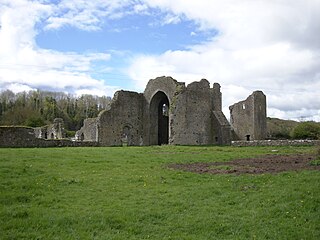
Ballybeg Priory, also known as Ballybeg Abbey, the Abbey of St Thomas, and St Thomas's Priory, is a 13th-century priory of the Augustinian order near the town of Buttevant, County Cork, Ireland. It is home to one of the best preserved and most substantial dovecots in Ireland. The priory was founded in 1229 and dissolved in 1541, the land and buildings passing into private hands. Those parts of the buildings that have escaped from the stone being removed for use in other buildings are mostly late medieval.
Strancally Castle is a country house in County Waterford, Ireland. It is located on the River Blackwater, close to the town of Youghal in County Cork.

Barryscourt Castle is a castle located in eastern County Cork in southern Ireland, close to the town of Carrigtwohill.
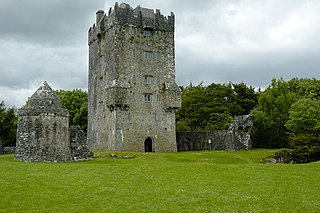
Aughnanure Castle is a tower house near Oughterard on the N59, in County Galway, in the west of Ireland. It was built by the O'Flaherty family in the late 15th century and fully restored in the 1960s. Today it is open to visitors from March to November.
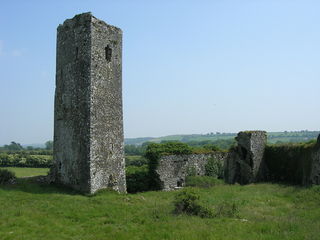
Ballincollig Castle is a Norman castle to the south of the town of Ballincollig, County Cork, Ireland, built after the Norman invasion of Ireland. In its prime, the castle was inhabited by the Barrett family, who had control of the local area. The castle still stands today, albeit largely in ruin. The original keep still remains, as does most of the curtain wall and two towers.

The Collegiate Church of Saint Mary the Virgin, also known as St Mary's Collegiate Church, is a large Anglican church in Youghal, east County Cork, Ireland. Dating to roughly 1220 and dedicated to the Virgin Mary, it is part of Youghal Union of Parishes, in the United Dioceses of Cork, Cloyne and Ross.

Mahoonagh or Castlemahon is a village and civil parish in County Limerick, Ireland. The village lies four kilometres south east of the town of Newcastle West.
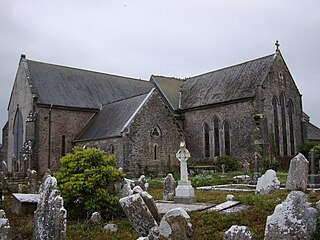
St. Colman's Cathedral, Cloyne is a cathedral of the Church of Ireland in Cloyne, County Cork in Ireland. It is in the ecclesiastical province of Dublin. Originally a Roman Catholic cathedral, it was converted to an Anglican cathedral in 1678.

Castle Salem is a fortified house near Rosscarbery, in County Cork, Ireland. The house was home to the Morris family from around 1660 until the early 1800s, and was bought in 1895 by the Daly family, descendants of whom now run it as a guest house.

Carrignamuck Tower House, located in Carrignamuck townland, is a 15th century tower house located 2.8 km (1.7 mi) north of Coachford village and 2 km (1.2 mi) north-west of Dripsey village. It is also sometimes known as 'Dripsey Castle', a name latterly attributed to the 18th century house, Dripsey Castle, built nearby.

Dripsey Castle is a country house in the townland of Carrignamuck, situated 3.3 km (2.1 mi) north-east of Coachford village and 2.5 km (1.6 mi) north-west of Dripsey village. The house and demesne were dominant features in the rural landscape of Ireland, throughout the eighteenth and nineteenth centuries. Location often reflected the distribution of better land, and this is evidenced in mid-Cork, where many of these houses are situated along the valley of the River Lee and its tributaries.

Roscrea Castle is a 13th-century motte-and-bailey castle in the town of Roscrea, Ireland. The castle consists of a walled courtyard, gate block, and angled towers. Along with 18th century Damer House and gardens, the castle forms part of Roscrea Heritage Centre.
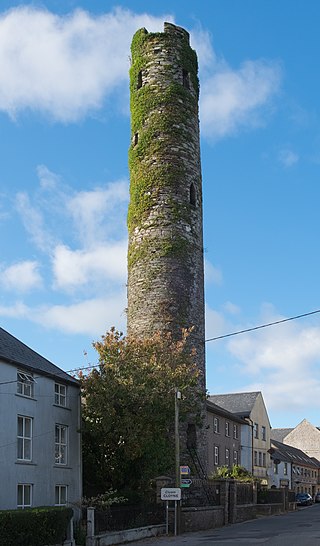
Cloyne Round Tower is a round tower in the historically monastic town of Cloyne, County Cork in Ireland. Cloyne was also the "see city" of the Anglican Diocese of Cork, Cloyne and Ross. The tower is a symbol for the town of Cloyne.

Castlemagner is a village and townland in the Duhallow area of north-west County Cork, Ireland. Castlemagner is within the Cork North-West.

Shandon Castle, originally known as Lord Barry's Castle, was an early medieval castle in the Shandon area of Cork city in Ireland. It was built in the late 12th century by Philip de Barry, close to an earlier ringfort. Located outside the city's gates and defensive walls, the castle was a seat of the Cambro-Norman de Barry family for several centuries.

















